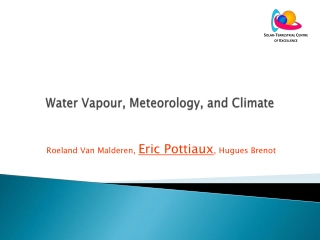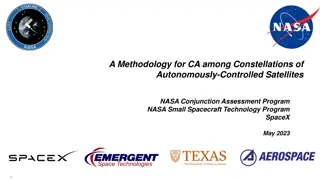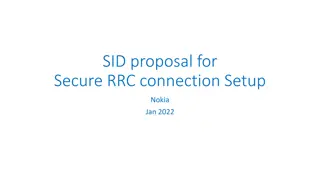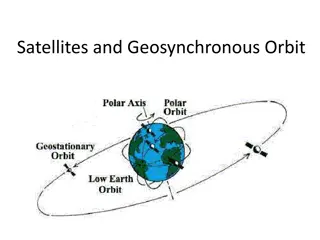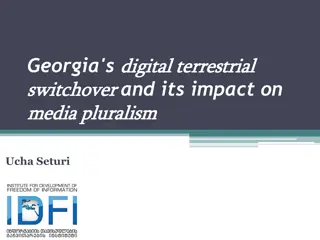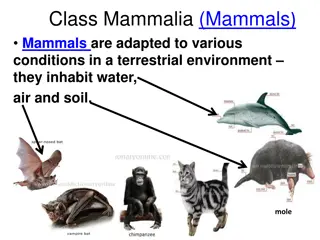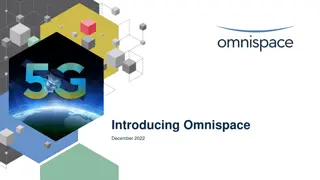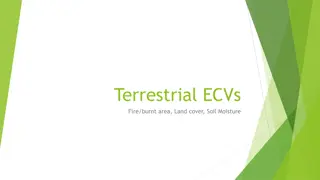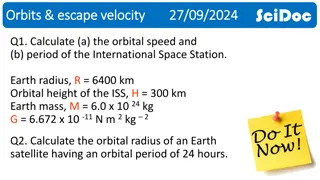Satellites for 5G in India: An Overview of Non-Terrestrial Networks
5G technology is rapidly evolving globally, with satellites playing a crucial role in expanding coverage and enabling new services. This overview dives into the necessity of Non-Terrestrial Networks (NTN) for reaching underserved areas, the different satellite categories, and the historical use of satellites in 2G and 3G networks by Indian operators.
Download Presentation

Please find below an Image/Link to download the presentation.
The content on the website is provided AS IS for your information and personal use only. It may not be sold, licensed, or shared on other websites without obtaining consent from the author.If you encounter any issues during the download, it is possible that the publisher has removed the file from their server.
You are allowed to download the files provided on this website for personal or commercial use, subject to the condition that they are used lawfully. All files are the property of their respective owners.
The content on the website is provided AS IS for your information and personal use only. It may not be sold, licensed, or shared on other websites without obtaining consent from the author.
E N D
Presentation Transcript
Satellites for 5G Anil Tandan Ex CTO Idea Cellular Ltd
Introduction 5G already launched in 49 Countries with 122 Commercial networks In India, DOT on threshold of giving approval for Trials on 5G by Operators 5G Spectrum auction likely in 2021 Cellular macro and micro base station densification is already underway in 4G to support high data rates, capacity and coverage. Many 5G technologies already being deployed by Indian Operators in 4G like Massive MiMo, Edge Computing, Cloud based EPC
5G is Enabling New Services & Use Cases Speed 100X for EMBB Latency 1 msec as compared to 200 msec for URLL Comns in 5G MMTC - Connectivity to Billions of devices Network Slicing NW is split to tailor the speed, capacity, coverage, encryption requirement of Users. 5G will be an elastic network - don t need to satisfy all these requirements all the time. Need to make sure 5G can satisfy the requirements of the particular Service
Why Need for Non Terrestrial Networks (NTN) Coverage of 4G to 90% population already achieved in India using Fibre and Microwave backhaul To reach next 10%, Fibre and MW neither cost effective nor technically feasible Bharat Net would certainly help in reaching some additional population Hence need for Non Terrestrial Network (NTN) for reaching the under served or unserved areas. NTN includes- GEO Stationary Satellites MEO Satellites LEO Satellites HAPS (High Altitude Platforms)
Satellite Categories GEO 35786 km Latencies much larger than on terrestrial network MEO 8000-20000 km Max. Dist: 40586 km Delay (one-way): 135.3 Relative Speed: ~0 m/s LEO 1500 km 135.3 ms ms HAPS 20-50 km LEO 600 km Max. Dist: 14018 km Delay (one-way): 46.7 ms 46.7 ms Max. Dist: 3647 km Delay (one-way): 12.1 12.1 ms ms EARTH Max. Dist: 1932 km Delay (one-way): 6.4 Relative Speed: ~7.5 km/s 6.4 ms ms Non GEO satellites are moving relatively to earth
Use of Satellites in 2G & 3G Indian operators have used Satellites (VSAT) for providing 2G & 3G networks in remote areas 2G launches in many towns for the first time were done using VSAT backhaul Mainly in big but remote towns of MP, Chhattisgarh, HP, J&K etc which did not have OFC and difficult to extend MW connectivity Also in unserved areas like Ladakh, Andaman Islands & other remote areas. Issues faced then were: Limited bandwidth availability Long process for Regulatory approvals High cost of equipment and bandwidth
Disruption in Space Satellite and launch cost decreases OLD Space New satellites, targeting low earth orbit (LEO), are getting smaller and lighter o GEO satellites weight: 1000s of kgs o SpaceX satellites weight: 384 kg o Nano satellites weight: between 1-10 kg GEO, 36000 km Disruption Disruption NEW Space LEO, 500-1000 km The low-earth orbits satellites are getting cheaper o Building cost o Launching cost
Test Beds for Satellite - Terrestrial Architecture EU Horizon 2020 - collaboration involving companies across Europe, with the goal to develop a Satellite and Terrestrial Network for 5G. Demonstrator for Satellite-Terrestrial Integration in the 5G Context (SATis5G)- funded by the European Space Agency SpaceX, OneWeb and Amazon - are developing low earth orbit (LEO) constellations to provide connectivity anywhere on the globe. High Throughput Satellite (HTS) technology in geostationary orbit (GEO) is another player in the convergence of the satellite-terrestrial network with 5G, offering spot beam and multicast capabilities. The cellular standards organization 3GPP is also working on defining the role of satellite communications in 5G through studies of non-terrestrial networks with satellites in LEO, medium earth orbit (MEO) and GEO.
Satellite Convergence With 5G Use Cases : identified for satellite integration with 5G networks, where the satellites connect to: 1. Trunks and head-ends for terrestrial networks in isolated, hard-to-reach areas. 2. User premises, providing direct service to underserved areas. 3. Moving platforms. 4. Hybrid architectures, complementing terrestrial capabilities with services such as multicasting.
Satellite Convergence with 5G Use Cases Explained Fixed Backhaul Fixed backhaul to Base Stations or individual small cells in underdeveloped and underserved regions Content To Premises Bringing ubiquitous high speed coverage to homes across a country is difficult, In underdeveloped regions, a hybrid xDSL terrestrial and satellite broadband link can provide service for homes and offices using distributed small cells connecting to the satellite. Moving Platforms Satellite links are practical for moving platforms, providing the capability to connect anywhere on the ground or in the air, regardless of the speed of the platform. Complementary Services for Low Density Areas Entails using the satellite to provide live or on-demand multimedia content, offloading it from the ground 5G infrastructure in areas with low population densities and where service costs are high. Major limitation for this application is the high latency of GEO satellite links.
Satellite Terrestrial Networks Bent pipe Satellite (= RF repeater) gNB Handheld or IoT Device Data Network 5G Core Network NG (= N2/N3) N6 NR Radio protocols NR Radio protocols (a) Regenerative Satellite (including gNB/DU) gNB/CU Handheld or IoT Device Data Network 5G Core Network NG (= N2/N3) N6 F1 interface (b) A satellite in a 5G satellite access network will have one of two architectures: Bent pipe gNB: The bent pipe simply redirects user data to the ground gNBs using NR protocols. Legacy relay satellites merely shift the incoming signals from the uplink to downlink frequencies, amplifying and transmitting without altering the original content. Regenerative gNB: Regenerative satellites have fully functional gNBs. Newer satellites with digital payloads can regenerate an incoming signal.
5G Future Releases 3GPP Release 16 finalised in June 2020 Release 17 Start of the work has been slowed down due COVID 19. Official timeline for freeze of specifications would be known later From Market point of view - Release 17 UE availability would be around mid 2023 (if Release 17 is finalized by mid 2022) Improvements to V2X, industrial IoT, multi-SIM devices, reliability and low latency performance, access to unlicensed spectrum to 71 GHz, efficiency and interference and other features are expected to be fleshed out. 5G new radio (NR) support from non-terrestrial access (NTN) technologies such as satellites and high altitude platforms included in Release 17 Satellite technology can be a contributing asset to the framework of 5G globally, due to the inherent benefits of the platform.
HTS Technology From the launch in 2004 of Anik F2, with a throughput of 4 Gbps, to the 2017 launch of EchoStar XIX, with a throughput of 200 Gbps, HTS technology has evolved dramatically. Soon, Tbps speeds will be feasible with Ka-Band transponders and optimization techniques to decrease the cost per bit. There is a goal for plug and play capability for the satellite network to support 5G through satellite network virtualization, allowance of the cellular network to control satellite radio resources, development of link aggregation for small cell connectivity, optimized security through key management and authentication between cellular and satellite access technologies and integration of the multicast benefits of satellite technologies.
HTS Enabling Technologies Spot Beams and Frequency Reuse Where beams are few and extremely large - spanning a continent - HTS satellites yield greater than 20x the throughput within the same frequency allocation, by using multiple spot beams balanced with frequency reuse. Multicast HTS technology is inherently capable of multicast, where one message does not have to be sent individually to a thousand users a thousand different times - rather, just once, providing more efficient use of the spectrum and data resources. Up the Spectrum Most recent HTS launches have used Ka-Band transponders. The shift to higher frequencies is to get greater bandwidth, which enables more spot beams. Future generations of satellites will provide terabit per second capacities, which will likely require Q- and V-Band feeder links to be able to aggregate more user traffic and split the coverage into thousands of spot beams.
MNOs generic requirements toward space-based systems Satellite system shall manage and limit interference with existing terrestrial networks (UL & DL) Satellite system shall enable direct communication to mass market smartphones Mobility between terrestrial and satellite networks is required Roaming is allowed on NTNs NTNs can be shared between MNOs In coverage of satellite system, mobile handsets battery consumption should remain comparable as when in terrestrial network coverage Ability to Lawful interception in the country
MNO Requirements Operators Preference To have an NTN solution based on 3GPP Standards to enable interoperability and integration with Terrestrial Systems, in particular the inter-operability between multi-vendor Satellite and Ground Based Equipment suppliers. This will impact 5G Standards Depending on the considered NTN scenario (orbit, device, frequency band), the following 3GPP NR/NG-RAN features may need to be enhanced: timing relationship, UL time and frequency synchronisation, random access,
NTN Related Definitions Based on 3GPP TR 38.821 Inter-satellite link Feeder link = radio link between NTN-gateway and satellite Service link = radio link between UE and satellite Inter-satellite link = optional link which may use RF frequency or optical transmission Non-GEO satellite served by one or several NTN-gateways at a time to enable continuity between the successively serving NTN-gateways Transparent payload = Radio Frequency filtering, frequency conversion and amplification. The waveform signal repeated by the satellite is un- changed Regenerative payload = includes also demodulation/decoding, switch and/or routing, coding/modulation. Equivalent to having base station functions on board the satellite Satellite Satellite Feeder link Service link (Uu) Gateway Core network
Terminology & Definitions Satellite-fixed vs. Earth-fixed cells Satellite-fixed cells Earth-fixed cells Steerable beams with dynamically adjusted pointing direction Radio coverage is stationary on earth Simple definition and management of Tracking Areas UE handovers occur during beam switch Fixed beams do not change pointing direction Radio coverage is moving on earth Simple RF/BB implementation on the satellite UE handovers occur continuously
Use Cases Rural Use Cases 5G Coverage distant and sparse populated areas In 27,721 villages of India, there are still no mobile connections due to various issues. Agricultural use case- Sensor data are collected via drones which are connected to a satellite system to provide the necessary network control and connectivity e.g supervision of the big farmlands, hilly areas Wind turbines and solar panels are often placed in rural locations. Need solar panels and turbines to be more plugged in because they are dependent on unpredictable resources, like weather and sun. Other Use Cases Shipping company Worldwide wants to track and trace containers. In order to do so, it has installed a UE on the containers that can report location and other parameters (e.g. temperature in the container) to a central server. Satellites efficient in multicasting or broadcasting a similar content over a large area, and potentially directly to user equipment. The wind power plant communication network at an off-shore wind farm connects to the on-shore and inland remote service centre via 5G satellite connection Internet of Things with a satellite network
Conclusion Vision of 5G is driven by the increased data rates and connection density, significantly reduced network latency, and optimized network efficiency. Recent years have also seen several advances in satellite systems and networks, allowing better efficiency, reliability, increased data rates, and new applications Standards organizations like 3GPP (Release 16 and now Release 17) have been working on these Non-Terrestrial Networks (NTN). 5G and beyond 5G satellite systems have to meet the KPIs in terms of peak data rates, spectral efficiency, connection density, e2e latency, delay jitter, and mobility. Satellite communication will play a significant role in 5G and beyond as a complementary solution for ubiquitous coverage, broadcast/multicast provision, aeronautical & maritime communications, emergency/disaster recovery, and remote rural area coverage.
Thank You anil.tandan@gmail.com
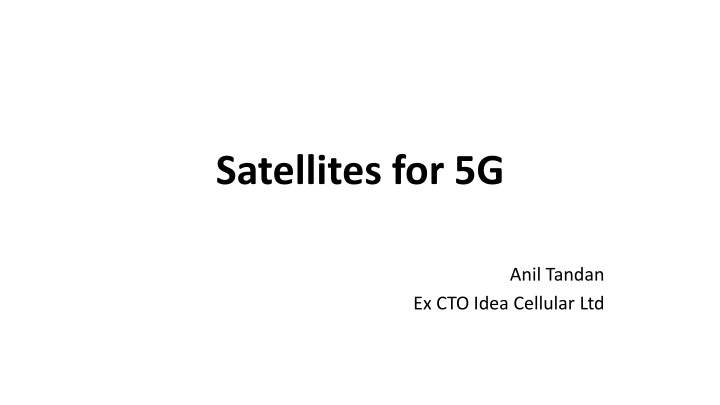

![[PDF⚡READ❤ONLINE] Neptune: The Planet, Rings, and Satellites](/thumb/21522/pdf-read-online-neptune-the-planet-rings-and-satellites.jpg)

